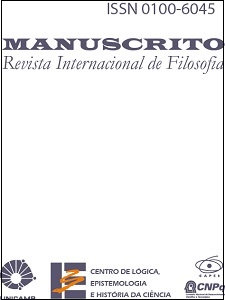Abstract
This paper revisits some of Chateaubriand’s critical considerations with regard to representing our reasoning practices in logic and mathematics by means of “idealized syntax”. I focus on the persistently critical side of these considerations which aim to prepare the ground for “an interesting epistemology of logic and mathematics” that ought to make room for understanding the pragmatic dimensions of proofs as explanatory rational displays. First, I discuss the 20th century “syntactic conception” of the logical and the underlying set of values it upholds. Secondly, I revisit the syntactic constraints on systematizing our formal forms of reasoning and ask about the relationship between “idealized” proofs construed as “syntactic objects” and the variety of formal forms of reasoning with its uses of the logical by the research mathematician. Finally, I consider the reasons why Chateaubriand thinks the syntactic requirements of “logical rigor” cannot be fulfilled, and why they ought not to be on the agenda. I conclude my paper by pointing to a deeper assumption which needs to be critically revisited as it stands in the way to what the author envisages as an “interesting epistemology of logic and mathematics”.
Resumo:
O presente artigo reconsidera algumas das considerações críticas de Chateaubriand com relação a representar nossa prática de raciocínios em lógica e matemática por meio de uma “sintaxe idealizada”. Concentro-me no aspecto invariavelmente crítico dessas considerações, que têm por objetivo preparar o terreno para “uma epistemologia interessante da lógica e da matemática”, a qual deve abrir caminho para a compreensão da dimensão pragmática de provas como exibição racional explicativa. Em primeiro lugar, discuto a “concepção sintática” da noção de lógica do século XX e o conjunto de valores que ela sustenta. Em segundo lugar, eu reconsidero as restrições sintáticas impostas à sistematização de nossos raciocínios formais e pergunto sobre a relação entre provas “idealizadas” construídas como “objetos sintáticos” e a variedade de modos formais de raciocínios com os seus usos do lógico pelos pesquisadores em matemática. Por fim, eu considero as razões pelas quais Chateaubriand pensa que os requisitos sintáticos do “rigor lógico” não podem ser satisfeitos, e por que eles não deveriam ser parte da agenda. Concluo meu artigo apontando uma assunção mais profunda que precisa ser reconsiderada criticamente uma vez que ela representa um obstáculo àquilo que o autor vislumbra como uma “epistemologia interessante da lógica e da matemática
References
BREGER, H. “Tacit Knowledge and Mathematical Practice”. In: E. Grosholz and H. Breger (eds.) (2000), pp. 221-230.
CELLUCCI, C. Filosofia e Mathematica. Roma: Editori Laterza, 2002.
CHATEAUBRIAND, O. Logical Forms. Part I: Truth and Descriptions. Campinas: CLE/UNICAMP, 2001. (Coleção CLE, v. 34)
CHATEAUBRIAND, O. Logical Forms. Part II: Logic, Language and Knowledge. Campinas: CLE/UNICAMP, 2005. (Coleção CLE, v. 42) CHEMLA, K. “History of Science, History of Text”. In: Boston Studies in the History and Philosophy of Science. Dordrecht: Springer 2005.
CHURCH, A. Introduction to Mathematical Logic. Princeton: Princeton University Press, 1956.
DUMMETT, M. The Logical Basis of Metaphysics. Cambridge: Harvard University Press, 1991.
ENDERTON, H. A Mathematical Introduction to Logic. San Diego, CA: Academic Publisher, 1972.
ETCHEMENDY, J. The Concept of Logical Consequence. Cambridge, Mass.: Harvard University Press, 1990.
FLOYD, J. SHIEH, S. (eds.). Future Pasts. The Analytic Tradition in Twentieth Century Philosophy. Oxford University Press, 2001.
FOMENKO, A. Visual Geometry and Topology. Berlin: Springer Verlag, 1994.
FREGE, G. Wissenschaftlicher Briefwechsel. Hamburg: Felix Meiner, 1986.
GOETHE, N. B. “Frege on Understanding Mathematical Truth and the Science of Logic”. In: B. Löwe, V. Peckhaus and T. Rasch (eds.) (2006), pp. 27-50.
GOETHE, N. B “Modes of Representation, Working Tools, and the History of Mathematics”. Historia Mathematica (Volume 35, 2008), DOI 10.1016/j.hm.2008.02.001.
GOLDFARB, W. “Frege’s Conception of Logic”. In: J. Floyd andShieh (eds.) (2001), pp. 25-41.
GROSHOLZ, E. Representation and Productive Ambiguity in Mathematics and the Sciences. Oxford/New York: Oxford University Press, 2007.
GROSHOLZ, E., BREGER, H. (eds.). The Growth of Mathematical Knowledge. Dordrecht/Boston/London: Kluwer Academic Publishers, 2000. (Synthese Library, v. 289) HADAMARD, J. The Psychology of Invention in the Mathematical Field. Princeton: Princeton University Press 1945. (New edition 1996, prefaced by P. Johnson-Laird) HALLET, M., MAJER, U. (eds.). David Hilbert’s Lectures on the Foundations of Geometry, 1891-1902. Berlin/Heidelberg/New York: Springer, 2004.
HARDY, G.A. “Mathematical Proof”. Mind, 38, 1929, pp. 1-25.
KLEIN, U. Experiments, Models, Paper Tools: Cultures of Organic Chemistry in the Nineteenth Century. Stanford: Stanford University Press, 2003.
LÖWE, B., PECKHAUS, V., RASCH, T. (eds.). Formal Sciences IV (Studies in Logic 3). London: College Publications, 2006.
MANCOSU, P. “Visualization in Logic and Mathematics”. In: P.nMancosu et al. (eds.) (2005), pp. 13-30.
MANCOSU, P. et al. (eds.). Visualization, Explanation and Reasoning Styles in Mathematics. Dordrecht: Springer, 2005.
NEEDHAM, T. Visual Complex Analysis. Oxford: Clarendon Press, 1997.
PASCH, M. Vorlesungen über neuere Geometrie, 1882/1926. (Reprint by Springer, 1976) PRAWITZ, D. “Logical Consequence from a Constructivist Point of View”. In: S. Shapiro (ed.) (2005), pp. 671-695.
QUINE, W. V. O. Elementary Logic. Boston: Ginn, 1941.
QUINE, W. V. O. Methods of Logic. New York: Holt, 1950.
RUSSELL, B. Introduction to Mathematical Philosophy. London: Allen and Unwin, 1919.
SHAPIRO, S. “Logical Consequence, Proof, and Model Theories”. In: S. Shapiro (ed.) (2005), pp. 651-670.
SHAPIRO, S. (ed.). The Oxford Handbook to the Philosophy of Mathematics and Logic. Oxford Scholarship, Oxford University Press, 2005.
TENNANT, N. “The Withering Away of Formal Semantics?”. Mind and Language, 1(4), pp. 302-318, 1986.
VAN BENTHEM, J. “Where is logic going, and why should it?. Topoi, 25, pp. 117-122, 2006.

